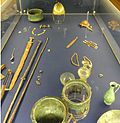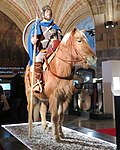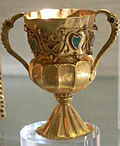Franks
The Franks or the Frankish peoples were one of several West Germanic federations of tribes.[1] It was formed out of Germanic tribes: Salians, Sicambri, Chamavi, Tencteri, Chattuarii, Bructeri, Usipetes, Ampsivarii and Chatti. Most of them lived at the northern borders of the Rhine.
They entered the late Roman Empire from the northern and eastern river banks of the Rhine into modern-day northern Belgium and southern Netherlands. Later invasions conquered and established a lasting kingdom in an area that eventually covered most of modern-day France, Belgium, the Netherlands, and western Germany. The pagan Frankish king Clovis became Christian in the late 5th century, which was an important event in the history of Europe.
Modern scholars of the Migration period agree that the Frankish confederacy emerged in the early the 3rd century. A region in north-eastrn Netherlands, north of what was Roman border, is still called Salland and may have received that name from the Salians, who formed the core of the Frankish sea raiders.
Frankish Empire
From their heartland, the Franks gradually conquered most of Roman Gaul north of the Loire valley and east of Visigothic Aquitaine. At first, they helped defend the border as allies; for example, when a major invasion of mostly East Germanic tribes crossed the Rhine in 406, the Franks fought against the invaders. In the region of Paris, Roman control persisted until 486, a decade after the fall of the emperors of Ravenna, in part because of alliances with the Franks.
Merovingians
In 451, Aëtius called upon his Germanic allies on Roman soil to help fight off an invasion by Attila the Hun. The Salian Franks answered the call. The Ripuarian Franks fought on both sides as some of them lived outside the Roman Empire. The Merovingian kings were assisted by their mayors of the palace, who were governors, led the Franks to war, and had many governing responsibilities.
Carolingians
The Carolingian kings begins with the deposition of the last Merovingian king and the coming to power in 751 of Pepin the Short, the father of Charlemagne.
Pepin ruled as an elected king. In France, the kingdom would become hereditary, but the kings of the later Holy Roman Empire proved unable to abolish the elective tradition and continued to be rulers chosen by prince-electors until the Empire's formal end in 1806.
In 768, Charlemagne (Charles the Great) came to power. He was a powerful, intelligent, and modestly-literate figure, became a legend for the later history of both France and Germany. He restored an equal balance between emperor and pope.
In 772, Charles started conquest that eventually defeated the Saxons. He incorporate their realm into the Frankish Kingdom. In 773 to 774, he conquered the Lombards and thus could include Northern Italy in his sphere of influence. He renewed the Vatican donation and the promise to the papacy of continued Frankish protection.
Charles created a realm that reached from the Pyrenees in the southwest (actually, including an area in Northern Spain (Marca Hispanica) after 795) over almost all of today's France (except Brittany, which the Franks never conquered) eastwards to most of today's Germany, including northern Italy and today's Austria. On Christmas Day, 800, Pope Leo III crowned Charles as "Emperor of the Romans" in Rome. Though Charles preferred the title "Emperor, king of the Franks and Lombards", as he did not want to get into conflict with the Byzantine Empire, the Frankish Empire became the successor of the (Western) Roman Empire. Charles died on January 28, 814 in Aachen, where was buried.
Charles had several sons, but only one survived him. The son, Louis the Pious, followed his father as the ruler of a united empire. When Louis died in 840, the Treaty of Verdun in 843 divided the empire into three:
- Louis' eldest surviving son, Lothair I, became Emperor and ruler of the Central Franks. His three sons in turn divided the kingdom between them into Lotharingia, Burgundy and (Northern) Italy. Those areas would later vanish as separate kingdoms.
- Louis' second son, Louis the German, became King of the Eastern Franks. The area formed the kernel of the later Holy Roman Empire, the cradle of Germany.
- His third son, Charles the Bald, became King of the Western Franks. The area later became the foundation for France.
Franks Media
Aristocratic Frankish burial items from the Merovingian dynasty
Detail of the Tabula Peutingeriana, showing Francia at the top
Frankish leader grave, c. 500, with golden Spangenhelm in Krefeld, Germany
A 6th century bow fibula found in north-eastern France and the Rhineland. They were worn by Frankish noblewomen in pairs at the shoulder or as belt ornaments.
Carolingian warrior on a war horse (8th to 10th century) with lance, round shield, chainmail and spangenhelm in the Coronation Hall of the Aachen City Hall in June 2014 on the occasion of the exhibition "Charlemagne – Power, Art, Treasures"
The Hornhausen rider stone is a 7th-century relief depicting a Frankish warrior on horseback with shield, longsword, and lance.
A chalice from the Treasure of Gourdon
The pinnacle of Carolingian architecture: The Palatine chapel at Aachen, Germany.
Related pages
Notes
- ↑ Jo Ann H. Moran Cruz and Richard Gerberding, Medieval Worlds: An Introduction to European History Houghton Mifflin Company 2004, p. 80
Sources
- Geary, Patrick J. Before France and Germany: the Creation and Transformation of the Merovingian World. New York: Oxford University Press, 1988. ISBN 0-19-504458-4.
- James, Edward. The Franks. (Peoples of Europe series) Basil Blackwell, 1988. ISBN 0-631-17936-4.









